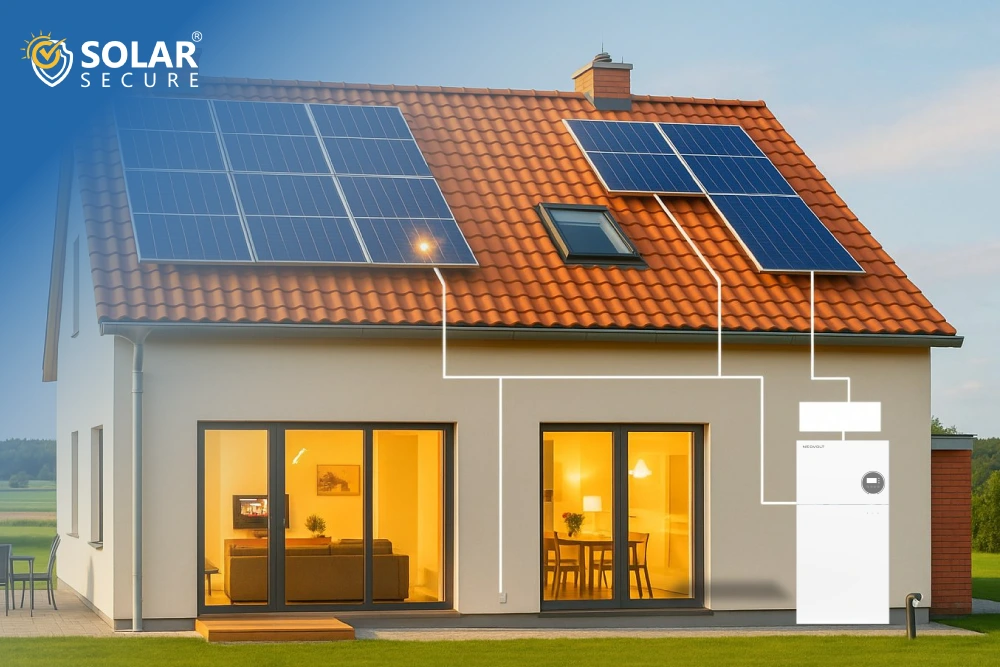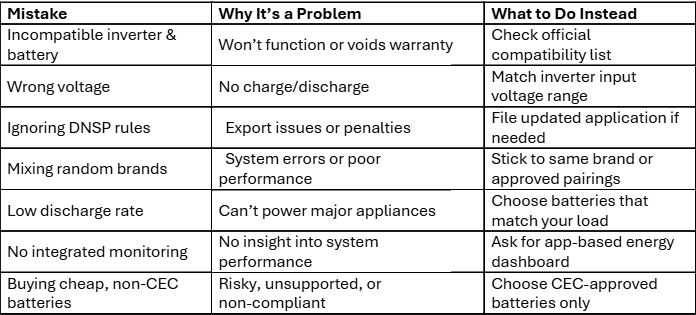Thinking of adding a battery to your existing solar system? That’s a smart move, but only if the new battery is compatible with your inverter, system design, and network requirements.
At Solar Secure, we’ve seen firsthand how mismatches can lead to unexpected costs, export issues, or unsafe operation. In this guide, we outline the most common compatibility mistakes Australians make when adding batteries and how to avoid them.
1. Choosing a Battery Incompatible with Your Inverter Not all batteries work with all inverters.
Some batteries require high-voltage hybrid inverters, while others only support AC coupling (adding the battery as a separate system). Trying to connect an incompatible battery can result in:
- Firmware errors
- Reduced efficiency
- Voided warranties
- Battery not charging at all
Tip: Always check if your inverter brand and model is on the manufacturer-approved compatibility list of the battery. If it’s not, then don’t risk it.
2. Overlooking Battery Voltage Requirements Batteries are usually:
- High-voltage (HV): Common in hybrid solar battery systems (e.g. Sungrow, BYD, Growatt).
- Low-voltage (LV): Found in older setups or DC-coupled battery inverters.
Trying to match a high-voltage battery to a low-voltage inverter or vice versa won’t work. This is a frequent issue when retrofitting batteries to older solar systems from 5–10 years ago.
Tip: Know your inverter’s input voltage range before buying a battery. Don’t assume just because the connector “fits” that it’s compatible.
3. Assuming All AC-Coupled Batteries Work the Same :
AC-coupled batteries (like Tesla Powerwall 2 or Enphase) connect to your home’s electrical system separately from your solar inverter.
But not all AC systems :
- Allow export limiting, especially with single-phase connections.
- Offer blackout protection (only available with backup switch or EPS function).
- Can be easily scaled or upgraded later .
Tip: If you’re considering AC-coupled batteries, ensure your solar retailer has designed the system to meet your grid and backup needs.
4. Not Updating Your Grid Connection or DNSP Approval:
Adding a battery can change your system’s output characteristics. Some electricity distributors (like Ausgrid, Jemena or SA Power Networks) require :
- Updated connection application
- Compliance certificates
- New CT meters or smart metering devices
Installing a battery without network approval can result in grid export blocks or disconnection notices.
Tip: Ask your installer if your DNSP requires a revised application for adding a battery. This is essential for grid compliance in 2025.
5. Mixing Brands Without Proper Integration Protocols
You cannot assume a battery from Brand A will work seamlessly with an inverter from Brand B, unless both support common integration protocols (like Sunspec, Modbus, or CAN bus). Mismatched communication leads to :
- “Unknown battery” or “no charge” errors
- Inverter shutting down
- Loss of monitoring or warranty support
Tip: Choose batteries and inverters from the same manufacturer or check for proven cross-brand compatibility from the supplier or Clean Energy Council.
6. Not Matching Charge/Discharge Rates with Load Needs
Let’s say you install a 10-kWh battery, but its discharge rate is capped at 3 kW. That may not be enough to run your home’s appliances during peak usage or in a blackout.
Similarly, a 5-kWh battery with a 0.5 kW discharge rate won’t handle even a basic split system A/C.
Tip: Check both the usable capacity and the maximum charge/discharge rate. A good rule of thumb: aim for a battery that can deliver 80–100% of your base load.
7. Ignoring Battery Monitoring Integration
Without proper monitoring :
- You won’t know if your battery is working
- You can’t optimise charging/discharging
- You lose visibility over energy flows and solar performance
Some older inverter-battery combos do not support unified monitoring via one app or portal.
Tip: Ask your installer for battery systems that offer integrated energy monitoring via a single dashboard (e.g. Sungrow iSolarCloud, SolarEdge monitoring, Tesla app).
8. Not Planning for Future Expansion
If you install a battery that isn’t scalable, you may regret it later as your energy needs grow. Worse, some batteries cannot be expanded once the system is closed, especially AC-coupled options :
Tip: If you’re planning to add more storage in future (e.g. for EVs), choose a modular and expandable battery system like:
- Sungrow SBR/SBH
- BYD Battery-Box Premium
- Growatt ALP/APX
- FoxESS EQ4800
- Sigenergy SigenStor
9. Buying Non-CEC Approved Batteries
In Australia, if your battery is not on the Clean Energy Council Approved Products list, it :
- Can’t be claimed under STC or VPP programs
- May not be accepted by your energy distributor
- Risks failing safety or compliance checks
Tip: Use only batteries listed on the CEC website: cleanenergycouncil.org.au
Summary Table: Mistakes to Avoid
Conclusion
Pairing a new battery with an existing solar system can significantly boost your home’s energy independence, reduce electricity bills, and enhance long-term savings, but only when done correctly. Many homeowners and even some installers overlook crucial factors like battery compatibility, inverter matching, voltage configuration, and system capacity, which can lead to inefficiencies, safety risks, or warranty issues.
To avoid these pitfalls, always start with a professional assessment of your current solar setup. Ensure your inverter supports battery integration, choose a battery that aligns with your system’s voltage and chemistry requirements, and verify that your monitoring software can manage hybrid functionality.
Investing the time to get expert advice and choosing reliable, compatible equipment ensures your battery add-on performs seamlessly with your solar panels. Ultimately, avoiding these common pairing errors will not only protect your investment but also maximise your system’s performance, energy savings, and sustainability impact for years to come.







